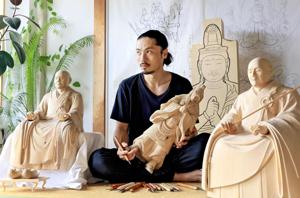
KYOTO - On a late September day, after the summer heat had subsided, as evening approached and the cicadas stopped buzzing, the sound of hand-carved wood filled an otherwise quiet workshop in Kyoto’s Minami Ward. Crunch, crunch, crunch..
. Gakyu Miyamoto sat on a tatami mat inside, carving a statue of the Buddhist guardian deity Idaten. He occasionally blew on the surface, sending wood shavings fluttering away and revealing the statue’s robe, which was gradually taking on a cloth-like texture.
Miyamoto plunged into the Buddhist sculptor’s profession from the world of fashion. That’s why his skills shine in carving clothing and accessories. When he’s about to carve clothing on a statue, he folds a real piece of cloth and faithfully recreates its drapes on the sculpture.
He also designs each statue’s accessories himself, sometimes incorporating motifs from Western art styles like Art Nouveau. Miyamoto’s style has earned him a strong reputation, and he’s received numerous work orders from renowned temples and shrines, including a request to repair the standing statue of Amida Nyorai (Amitabha) at Kiyomizu Temple and create statues of shishi and komainu (guardian lions and dogs) for Shimogamo Shrine. He has a large following on social media.
On the platform X, formerly Twitter, a photo of one of his statues was described as “too handsome for a Buddhist statue” and received 60,000 likes. He has more than 70,000 followers across his social media accounts. Currently, Miyamoto has about 100 projects on his list, with delivery dates extending to as late as 2041.
He works daily, aiming to create “Reiwa era statues of the kind that only I can make.” Miyamoto was born in Kyoto’s Fushimi Ward, not far from his current workshop. As a child, he would lose track of time drawing on the blank backs of flyers whenever color pencils were available.
When he was in junior high, he became interested in fashion and aspired to become a designer. After high school, he studied clothing at a junior college in Kyoto and then attended a vocational school in Tokyo on a scholarship. However, he was so confident in his talent that he wasn’t satisfied with his studies.
He graduated with minimal attendance. After returning to his hometown, he lived in a low-cost apartment without a bathtub and worked part-time to support himself while trying to become a professional painter. About six months later, as he began to question his path, his older brother suggested helping out a Buddhist sculptor.
The sculptor, a friend of his brother, was looking for someone skilled in painting. Miyamoto visited the workshop near Kiyomizu Temple and was assigned to color a Buddhist statue. Although new to him, he was immediately captivated by the work.
“Fashion items are consumed one after another, but Buddhist statues last for centuries. Are [the artists] thinking about the time after their deaths as they do the job?” Miyamoto wondered, feeling overwhelmed by the scale of the work. While helping in the workshop, Miyamoto noticed that making Buddhist statues shares similarities with dressmaking.
His knowledge of cloth textures and anatomy, acquired from dressmaking, proved useful for sculpture. “The gears of my life perfectly fit into place and began to turn,” he said. He quit his part-time job and officially apprenticed to the sculptor at 25.
From then on, Miyamoto sculpted Buddhist statues almost every day from morning until night. He felt he had to work three or four times harder than others because he started late. After nine years of training, he became independent in 2015 and adopted the sculptor name “Gakyu.
” Gakyu consists of two Chinese characters meaning “self” and “rest.” He chose the name as a reminder, since his teacher often told him, “Your flaw is that you are strong-willed.” Initially, Miyamoto received no orders.
But after displaying his creations at exhibitions, he began securing jobs. His work gained popularity on social media, increasing the number of orders. Currently, he’s working on 30 different statues.
His mood and physical state influence his work. His high spirits impact his statues and can even give them fierce expressions. As he works on statues of various types with unique characteristics, he centers himself through meditation and chooses the statue that best matches his state.
To create his statues, Miyamoto studies sculptures from Japan and abroad. For modern touches, he sometimes borrows from the aesthetics of show business figures. He also learns about current trends from reactions to his work on social media.
He has also encountered challenges in pursuing timeless beauty. Seeing the seated statue of Miroku Bosatsu (Maitreya) at an exhibition left him awestruck by its divine presence. The statue at Kyoto’s Daigo Temple was created by Kaikei, a famed sculptor from the 12th and 13th centuries.
He thought, “I’ll never be able to reach this level.” Yet this moment soon became his new goal. “At some point before I leave this world, I want to carve a supreme Buddha statue of unchanging beauty.
” Driven by ambition, his chisel breathes a thousand years of life into his sculptures..














